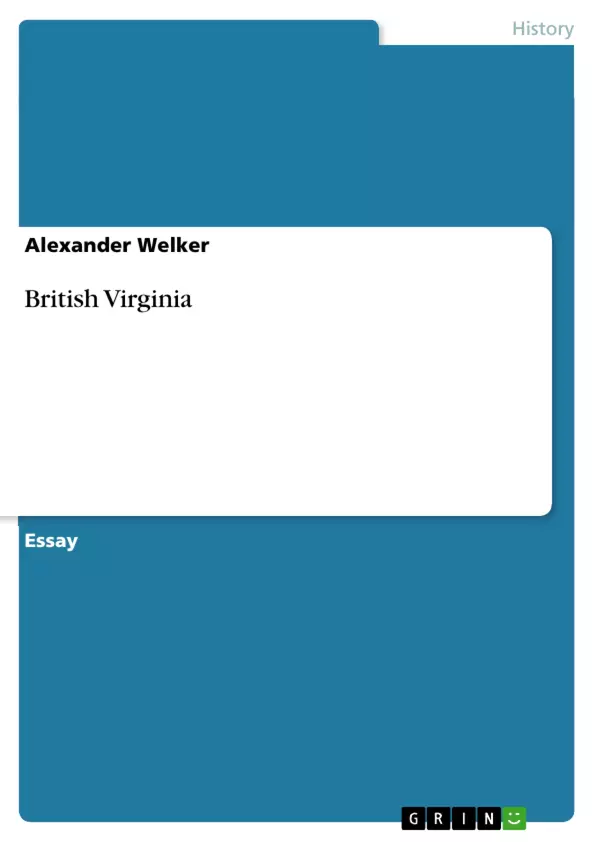Although the establishment of the Roanoke colony in Virginia (1585-1590), the first British colony in America, resulted in a total disaster, the British Empire was not discouraged to undertake a new colonization attempt on the North American continent about sixteen years later. In the Chesapeake Bay area, the today’s Virginia, a new colony, Jamestown, was established in 1607. Though in the first years after founding Jamestown the settlers were confronted with countless problems, the settlement finally overcame these difficulties and developed to a prosperous colony. For a long time seventeenth-century Virginia was regarded as a society only interested in profit and private gain, exploiting and ignoring the sufferings of servants and slaves. But at the same time it was also a society which developed a social conscience and established the first functioning political institutions of the contemporary United States. The aim of this paper is to examine British Virginia from inception onward, investigating how Virginia’s colonial society transplanted its desires and aspirations to the New World, adapted to (or not) and/or altered its new environment, and dealt with the indigenous peoples it encountered.
Inhaltsverzeichnis (Table of Contents)
- Introduction
- The Founding of Jamestown
- The “Starving Time” and the Tobacco Boom
- Relations with the Powhatan Confederacy
- From Settlement to Royal Colony
Zielsetzung und Themenschwerpunkte (Objectives and Key Themes)
This paper aims to provide a comprehensive overview of the early history of British Virginia, focusing on the challenges faced by the colonists in adapting to their new environment, their interactions with the indigenous population, and the social and economic development of the colony. Key themes explored include:- The struggle for survival in the early years of the Jamestown settlement
- The impact of tobacco cultivation on the Virginia economy and society
- The complex and often volatile relationship between the colonists and the Powhatan Indians
- The evolution of the colony from a private venture to a royal colony
Zusammenfassung der Kapitel (Chapter Summaries)
Introduction
This section introduces the historical context of British Virginia, highlighting the challenges of early colonization efforts and emphasizing the eventual success of Jamestown despite initial setbacks. The focus is on the transformation of Virginia from a struggling settlement into a prosperous colony.The Founding of Jamestown
This chapter details the arrival of the first colonists in Virginia in 1607, the establishment of the Jamestown settlement, and the various challenges they faced, including malaria, disease, food shortages, and conflict with native tribes. The importance of choosing a strategic location for the settlement and the impact of environmental factors on the colony’s survival are discussed.The “Starving Time” and the Tobacco Boom
This chapter explores the devastating “starving time” that Jamestown experienced in the winter of 1609-1610, highlighting the colonists’ struggle for survival and the role of food shortages and disease in the colony’s high mortality rate. The introduction of tobacco cultivation by John Rolfe in 1612 is presented as a turning point, transforming Virginia’s economy and social structure. The chapter also explores the harsh conditions faced by indentured servants working on tobacco plantations and the social inequalities that emerged as a result of the tobacco boom.Relations with the Powhatan Confederacy
This section examines the early interactions between the colonists and the Powhatan Confederacy, emphasizing the importance of peaceful relations with the native population for the colony’s survival. The chapter discusses the relationship between Captain John Smith and Chief Powhatan, the changing dynamics of relations as the colonists settled permanently in the region, and the escalating conflicts that ultimately culminated in the 1622 massacre of colonists.From Settlement to Royal Colony
This chapter concludes by examining the political evolution of Virginia, highlighting its transition from a private colony to a royal colony under the control of the English Crown in 1624. The development of the colony’s political institutions, including the House of Burgesses, and the expansion of tobacco agriculture leading to land conflicts with the native population are discussed. The chapter concludes by reflecting on the promise of economic gain that attracted colonists to Virginia and the reality of a society marked by exploitation and inequality.Schlüsselwörter (Keywords)
This text focuses on the early history of British Virginia, exploring themes of colonization, survival, economic development, relations with indigenous peoples, and social and political transformation. Key terms include Jamestown, “starving time”, tobacco cultivation, indentured servitude, Powhatan Confederacy, Captain John Smith, Chief Powhatan, Pocahontas, Bacon’s Rebellion, and royal colony.- Quote paper
- Alexander Welker (Author), 2012, British Virginia, Munich, GRIN Verlag, https://www.grin.com/document/229703



